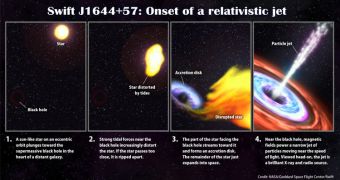In late March, astronomers began observing a new source of X-rays in the night sky. After monitoring the event for a while, they were able to conclude that they were witnessing the reawakening of a black hole. The process takes place as the massive object is consuming a nearby star.
When the first signs of the event were discovered, astronomers thought it could any of a number of cosmic events. However, data from the NASA Swift satellite indicated that the flare was growing in both intensity and brightness.
The new source is located in the constellation Draco. Experts say that they expect to see the X-ray jets shine well into next year, which is extremely unusual for a standard source of such radiation. Usually, flashes last only briefly, rarely for more than a few days.
In a series of new papers published in the August 25 issue of the top scientific journal nature, the investigators were able to provide more details on how these radiation sources function. The object has been named Swift J1644+57.
“Incredibly, this source is still producing X-rays and may remain bright enough for Swift to observe into next year. It behaves unlike anything we've seen before,” Pennsylvania State University astronomy professor David Burrows explains.
The expert also holds an appointment as the lead scientist for the Swift X-Ray Telescope instrument. He was part of the team that determined the X-ray source to be the formerly-dormant black hole at the core of a very distant galaxy. The object is located about 3.9 billion light-years away.
The Japan-led Monitor of All-sky X-ray Image (MAXI) instrument aboard the Kibo module on the International Space Station (ISS) also contributed to the work. X-ray and gamma-ray observations were combined for the first of the two Nature papers.
The second one included data from numerous radio observatories on the ground, including the National Radio Astronomy Observatory-operated (NRAO) Expanded Very Large Array (EVLA)/
“The radio emission occurs when the outgoing jet slams into the interstellar environment. By contrast, the X-rays arise much closer to the black hole, likely near the base of the jet,” says Harvard-Smithsonian Center for Astrophysics post-doctoral fellow Ashley Zauderer, the leader of the second study.
Astronomers now believe that the black hole at the core of this galaxy was activated when a star passed to close to the object, and began being disintegrated. Swift J1644+57 meticulously extracts matter from its companion, channeling it into its accretion disk, and releasing powerful jets of radiation.
“Our observations show that the radio-emitting region is still expanding at more than half the speed of light,” Harvard University associate professor of astrophysics Edo Berger explains. He was a coauthor for the second Nature paper.
“By tracking this expansion backward in time, we can confirm that the outflow formed at the same time as the Swift X-ray source,” the expert concludes.

 14 DAY TRIAL //
14 DAY TRIAL //